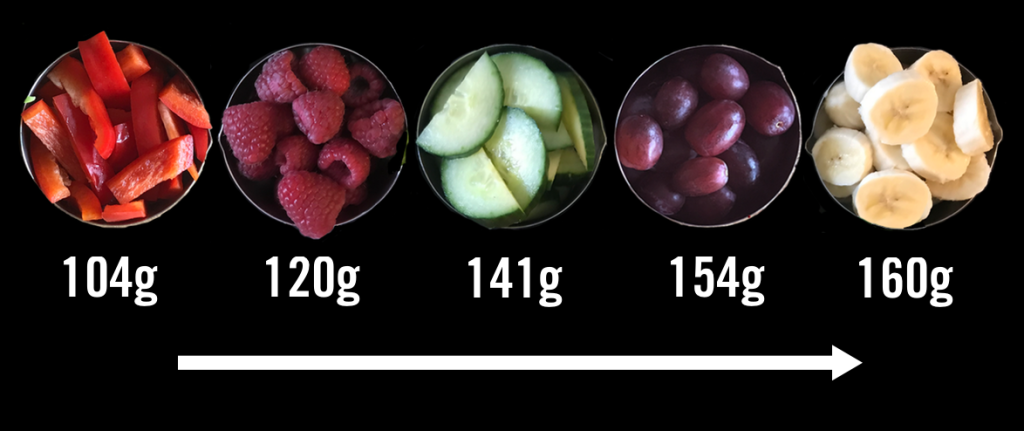Welcome to Week 1!
Estimating Quantity
The expectation for the #800gChallenge is that when you are at home or work, you are weighing and measuring your fruits and vegetables using a scale. However, we want this challenge to be realistic and instill some lasting habits past the challenge dates. As such, if you are out at a restaurant or visiting extended family who may not be used to your diet particulars, you can eyeball those fruit and vegetable sides or salad greens. No need to cause a scene by pulling out the scale.
We do expect that you will use information from restaurant websites or menus where available (e.g., Chipotle). The consistent weighing and measuring at home and work will help ensure pretty good accuracy for eyeballing on sporadic occasions, while also avoiding a lengthy explanation to your tablemates when you have done your due diligence by ordering the side of broccoli. Note, a standard serving size of vegetables at restaurants is ~75-85 grams (g) (1,2).
Eyeballing
A very general method to estimate fruits or vegetables is that a measuring cup runs ~100g. The low-to-high range found in a cross-section of common fruits and vegetables is 104-160g/cup (see picture). Less dense items like chopped bell pepper are relatively light and denser items like sliced bananas are relatively heavy. A cup is about the size of an average adult closed fist, which can help with the eyeball estimates.

The exceptions are leafy greens since they are very light and mashed potatoes since they are very heavy. A good approximation for leafy greens is that a packed cup contains only ~25g. This means it may take a full plate of greens to get ~100g. Conversely, a packed cup of sweet potatoes is ~260g.

Errors in Measurement
It is unlikely you will be 100% accurate with these eyeball measurements, but the good news is that you will not likely be far off. With an educated guess based on the above information, a “terrible” estimate will likely only put you ~50g off. While that is not ideal for every single serving, the weighing and measuring at home will make this an exception versus the rule. For those individuals tracking specific macronutrients (e.g., carbohydrates), these errors in eyeball measurements will also not be significant. Fruits and vegetables are nutrient dense but calorically poor foods. If someone overestimates a cup of grapes by 50g, this results in only being off by ~9 carbohydrate grams.
Reaching the #800g Total
Many have not tracked their mass of fruits and vegetables only – particularly in grams. Understanding what 800 grams “looks like” in terms of measuring cups can help individuals visually conceptualize and plan for their day. Virtually all combinations of 800g of different fruits and vegetables can all fit on a standard dinner plate, but no one sits down to that type of volume at one sitting. Assuming you are eating three main meals, one way to tackle this challenge is to plan for two cups of fruits or vegetables with each meal (~two closed fists) and as many leafy greens as you want. With that plan, you should consistently hit that #800g target!
Good luck!
References
-
Condrasky, M., Ledikwe, J.H., Flood, J.E., & Rolls, B.J. (2007). Chef’s Opinions of Restaurant Portion Sizes, 15(8), 2086-2094.
-
Reinders, M.J., Huitink, M., Dijkstra, S.C., Maaskant, A.J., & Heijnen, J. (2017). Menu-engineering in restaurants – adapting portion sizes on plates to enhance vegetable consumption: a real-life experiment. International Journal of Behavioral Nutrition and Physical Activity, 14, 41. doi 10.1186/s12966-017-0496-9
